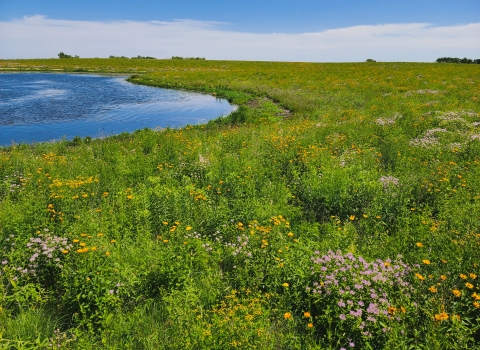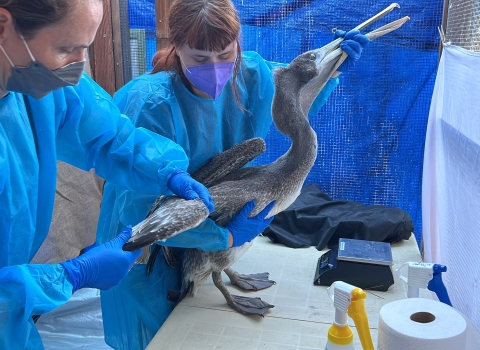DENVER – In southwestern Colorado, a tiny, wispy plant found only in Gunnison and Saguache counties is maintaining a stable, long-term population, which is why the U.S. Fish and Wildlife Service today announced it is not warranted for listing under the Endangered Species Act (ESA). The skiff milkvetch, an inhabitant of gravelly soils and steep, sparsely vegetated slopes in open sagebrush sagebrush
The western United States’ sagebrush country encompasses over 175 million acres of public and private lands. The sagebrush landscape provides many benefits to our rural economies and communities, and it serves as crucial habitat for a diversity of wildlife, including the iconic greater sage-grouse and over 350 other species.
Learn more about sagebrush country, is an isolated native flowering plant species found nowhere else in the world.
The Service’s finding is based on a comprehensive review of the best available science through a Species Status Assessment (SSA) that indicates ESA protection is not necessary. The Bureau of Land Management (BLM), Colorado Natural Heritage Program, Colorado Natural Areas Program, and Gunnison County each contributed to developing the Service’s SSA.
In making the current finding, the Service revisited our previously published 2010 determination that skiff milkvetch warranted ESA protection but that listing the species was precluded at the time by other listing actions of higher priority. We were most recently petitioned in 2007 to assess the conservation status of the species.
Since 2010, the Service has worked with conservation partners at the federal, state and local levels to assess the conservation status of this unique sagebrush ecosystem plant. The SSA shows periodic drought and climate change climate change
Climate change includes both global warming driven by human-induced emissions of greenhouse gases and the resulting large-scale shifts in weather patterns. Though there have been previous periods of climatic change, since the mid-20th century humans have had an unprecedented impact on Earth's climate system and caused change on a global scale.
Learn more about climate change are the main stressors driving the current and future condition of skiff milkvetch. Yet, plant population and habitat measures for skiff milkvetch currently show a stable long-term population trend. Seasonal dormancy may help skiff milkvetch survive warm and dry conditions. The science also indicates skiff milkvetch has a moderate ability to withstand potentially harmful random future disturbance events across its range (within South Beaver Creek and Cebolla Creek areas). Skiff milkvetch is therefore expected to continue occupying its native habitat and remain resilient to future threats.
This plant species occupies about 310 acres, primarily on public lands managed by BLM (including overlap with the Hartman Rocks Recreation Area), with small amounts of habitat on private lands. Roughly 96 percent of skiff milkvetch’s occupied habitat on BLM-managed lands is located within an Area of Critical Environmental Concern (ACEC), which is a designated area within existing public lands that BLM recognizes as needing special management attention to protect natural resources.
Actions BLM has taken to protect skiff milkvetch include designating the South Beaver Creek ACEC in 1993 and placing skiff milkvetch on BLM’s sensitive species list. Colorado has also designated the South Beaver Creek natural area for skiff milkvetch conservation in cooperation with BLM, an area that overlaps with the BLM’s ACEC and is open to public access. Ongoing actions by these conservation partners will continue to safeguard the health and stability of skiff milkvetch for future generations.
Skiff milkvetch was initially collected by botanist Rupert Charles Barneby in 1945 and is a member of the pea and legume family. It generally grows less than a foot tall (usually no more than 30 centimeters or 11.8 inches). The short, spindly plant produces pearly white summer flowers with petals flaunting a subtle splash of purple, brandishing a delicate lilac tinge.
A notice in the Federal Register will be published by the Service announcing the not warranted finding on December 19, 2019. The purpose of the Endangered Species Act is to protect and recover imperiled species and the ecosystems upon which they depend. A rigorous scientific analysis evaluating potential threats as well as current and future conditions is conducted prior to making any determination to list or not list a species.
The mission of the U.S. Fish and Wildlife Service is working with others to conserve, protect, and enhance fish, wildlife, plants, and their habitats for the continuing benefit of the American people. For more information on our work and the people who make it happen in the West, connect connect with us through any of these social media channels: Facebook, Twitter, Flickr, YouTube, and Instagram.


